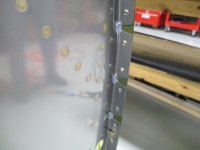<< It may or may not unseal when the firewall is subjected to fire, the question being "will the sealant remain adhered to hot stainless?". Second question is 'will it make smoke?">>
The answer to both questions seems to be "no".
Subject material is 3M Fire Barrier 2000+, the silicone base intumescent caulk. I applied a bead to both the front and back of the stainless "firewall" panel on my little burn rig. The rig is calibrated to roughly 2000F degrees, so results may be a little different for the hot side at lower temperatures.


These were taken about 60 seconds into the burn.
On the "engine" side, the sealant did pretty much as expected; it swelled up and ablated. Didn't notice any charring. As the silicone binder burned away, the solids tended to be blasted off the surface by the flame jet. At the 60 second point most of it was gone.
The surprise was the "cockpit" side. When I flipped the burner to high, the entire sealant strip released and fell off the stainless surface before I could even get around the backside to observe. This was well before the firewall panel glowed red. You can see it in the above photo, and here is the undamaged strip:

The ablated material from the hot side easily crumbles to powder.

Ok, there is nothing very "scientific" about this check. I didn't make any effort to tightly control the test conditions, in particular surface preparation. However, I think we can make a few valid observations.
1. Hot side performance (ablation) was tested at or above the maximum manufacturer's spec under dsirect flame (after all, they do call it Fire Barrier
2000). It may work better at lower temperature levels or with a thicker bead. I'd suggest the best application would be one with mechanical shielding of the sealant, like standard firewall pass-through shields or a washer.
2. The ability of this sealant to adhere to clean stainless is questionable when heated. This check suggests that in the event of fire, it will release and do nothing if applied as a bead on the back side of the firewall.
3. I observed no significant smoke.
4. Probably a fine sealant to keep ordinary fumes and CO out of the cockpit under normal conditions. There may be better choices if you consider things like oil resistance; not a subject here.









